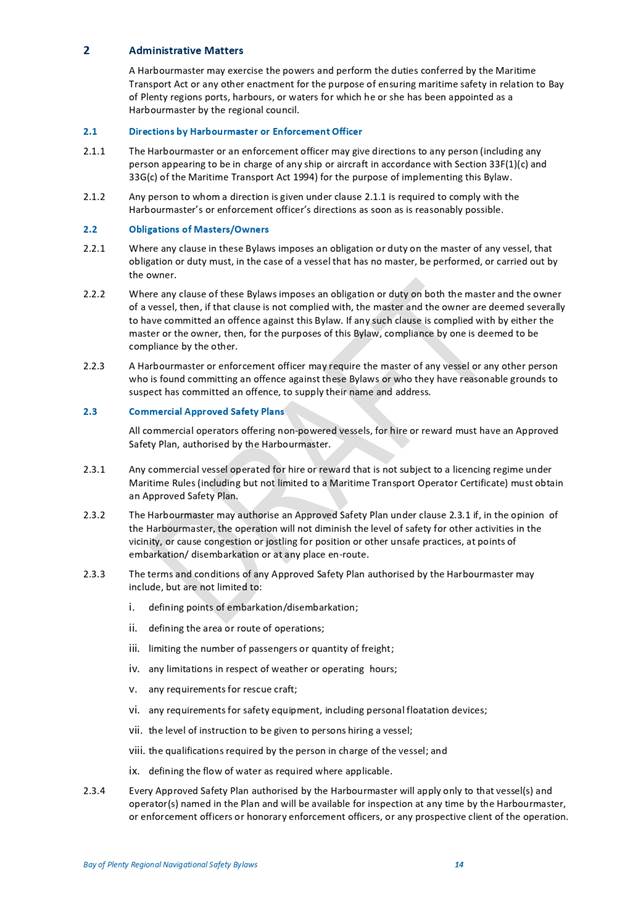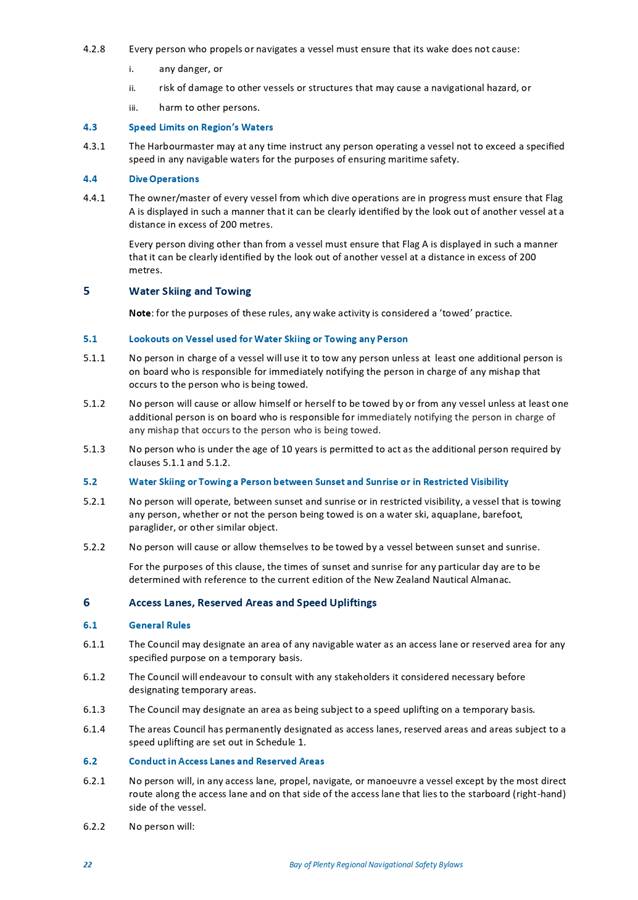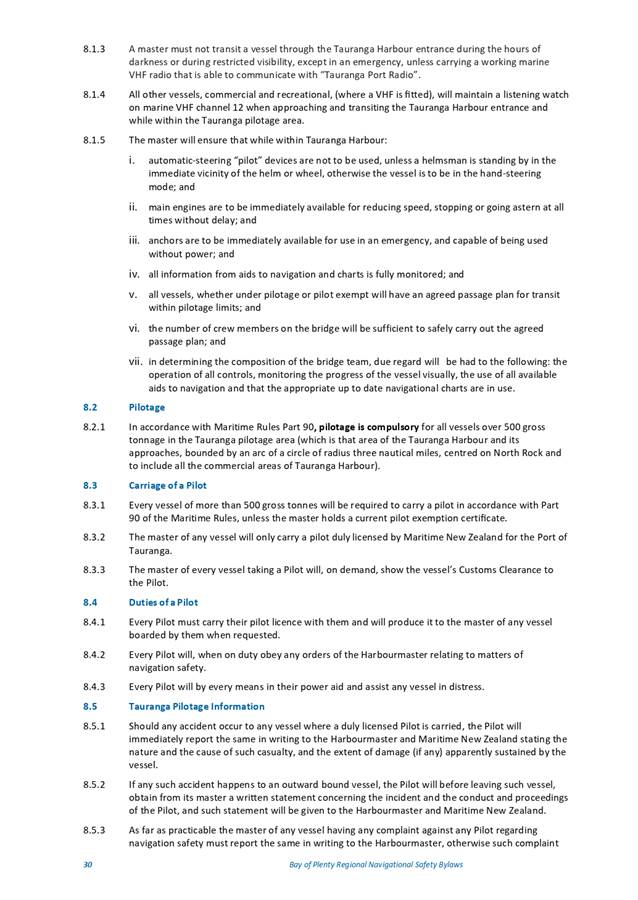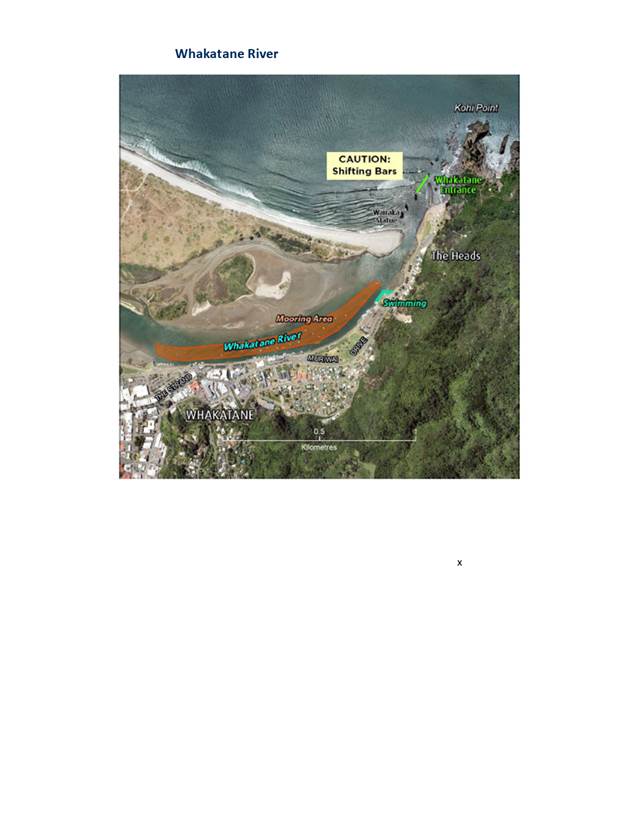|
|

|
|
|
|
Report To:
|
Regional
Council
|
|
Meeting
Date:
|
12
September 2024
|
|
Report
Writer:
|
Toni Briggs, Senior Project Manager
|
|
Report
Authoriser:
|
Reuben
Fraser, General Manager, Regulatory Services
|
|
Purpose:
|
To summarise the recommendations of
the Navigation Safety Bylaws Review Committee.
|
|
|
|
Adoption
of the Bay of Plenty Regional Navigation Safety Bylaws
|
Executive Summary
Bay of
Plenty Regional Council has a statutory role in ensuring maritime safety
in its region by developing Navigation Safety Bylaws under section 33M of the
Maritime Transport Act 1994. The Bay of Plenty Regional Navigation
Safety Bylaws are in place to minimise the risk of fatalities, injuries,
accidents, collisions, and damage in the Bay of Plenty navigable waters.
The Local Government Act 2002
requires Council to undertake a comprehensive review of its bylaws ten years
after it was last reviewed; and within a two-year timeframe from that review
date. Bay of Plenty Regional Council generally reviews the Bay of Plenty
Regional Navigation Safety Bylaws every five years to ensure that the Bylaws
reflect the most up to date legislation, latest best practice, up to date
maritime regulations and rules, and current regional risks and issues.
This last full review was in 2017.
At the end of 2019, as an
alternative to traditional Hearings panels, staff recommended that for this
review a Committee of Council be made up of Councillor representatives and
representatives able to provide an overall tangata whenua view.
The Bay of Plenty Navigation
Safety Bylaws Review Committee now presents a new Navigation Safety Bylaws
document for adoption.
|
Recommendations
That the Regional Council:
1 Receives the report, Adoption of the Bay of Plenty Regional
Navigation Safety Bylaws;
2 Agrees that under s155 of the Local Government Act, a
Bylaws document is the most appropriate form of regulation to address
navigation safety in the region and is not inconsistent with the New Zealand
Bill of Rights Act 1990;
3 Agrees with the endorsement of the Navigation Safety Bylaws
Review Committee and adopts the Bay of Plenty Regional Navigation Safety Bylaws
2024;
4 Agrees that the Bylaws comes into force on 1 October 2024;
5 Agrees with the recommendation of the Navigation Safety
Bylaws Review Committee to disestablish the Committee upon adoption of the
Bylaws and re-establish the Committee in the near future to further review
Hunters Creek/Otapu ski area;
6 Agrees with the recommendation of the Navigation Safety
Bylaws Review Committee that before the next 5 yearly review of the Bylaws Council reviews:
a. An extension of the Astrolabe Reef exclusion
zone for vessels over 500 gross tonnes for the purposes of navigation safety
b. Keep a watching brief on the East coast
shipping route to investigate the use of Navigation Safety bylaw powers to
enhance safety aspects of this coastal route
c. The prohibition of anchoring within the
Tauranga Harbour shipping channel
7 Authorises the Chief Executive to make minor numerical,
editorial or presentation amendments prior to the final publication.
1. Introduction
Bay of
Plenty Regional Council has a statutory role in ensuring maritime safety
in its region by developing Navigation Safety Bylaws under section 33M of the
Maritime Transport Act 1994. The Bay of Plenty Regional Navigation Safety
Bylaws are in place to minimise the risk of fatalities, injuries, accidents,
collisions, and damage in the Bay of Plenty navigable waters.
The Local Government Act 2002
requires Council to undertake a comprehensive review of its bylaws ten years
after it was last reviewed; and within a two-year timeframe from that review
date. Bay of Plenty Regional Council generally reviews the Bay of Plenty
Regional Navigation Safety Bylaws every five years to ensure that the Bylaws
reflect the most up to date legislation, latest best practice, up to date
maritime regulations and rules, and current regional risks and issues.
This last full review was in 2017.
Previous Bylaws reviews had
divided opinion in the community on a small group of topics, particularly Ohiwa
Harbour jetski exclusion; Hunters Creek Ski Lane; and speed uplifting on the
Kaituna river.
Previous
Hearings Panels have been composed of Councillors only (2004 and 2010) and
Commissioners only (2017).
At the end of
2019, as an alternative to traditional Hearings panels, staff recommended that
for this review a Committee of Council be made up of Councillor representatives
and representatives able to provide an overall tangata whenua view. This
Committee, it was proposed, would meet regularly over a 12-month period and
undertake the whole process of review, consultation and deliberation of a new
Bylaws document.
This was due to
the following reasons:
· The need for the Committee to meet on the issues and to develop a
relatively deep understanding, balanced with efficient decision-making.
· The need for tangata whenua to input into the decision-making
process as some of the legacy issues directly affect mana whenua.
· As a consequence of the complexity of the legacy issues, the view is
that the Committee will be closer to “decision-making” than
“advisory”, though final adoption of a Bylaws document will need to
be done by full Council as outlined in Schedule 7 of the LGA 2022.
The Committee
met a number of times to work through the review of the current Bylaws and
development of a new Bylaws document.
The meetings
were made up of:
|
Pre-Committee:
|
· Background information on Maritime history and
development of maritime legislation in New Zealand.
· General Bylaws introduction
· Excerpts from the Maritime Transport Act 1994 and
relevant Maritime Rules
· A copy of the current Nav Safety Bylaws
· Synopses on legacy issues that were most likely to
generate submissions.
|
|
Meeting 1:
(26 Jul 22)
|
An introduction to the
Regional Navigation Safety Bylaws and the importance of having localised
regulation of navigation safety.
|
|
Meeting 2:
(25 Aug 22)
|
Further supporting
discussion on:
· Clarification of legal concepts and influencing
regulation
· Position on ‘nuisance’ discussion.
· Background on Bylaws and their specific purpose.
|
|
Meeting 3:
(20 Sep 22)
|
· Understanding the technical and operational aspects
of Navigation Safety.
· A discussion from Maritime staff on the local
operational aspects of managing navigation safety.
· Discussion on Moorings.
|
|
Meeting 4:
(15 Feb 23)
|
· Presentation from Maritime Staff on aspect of
managing specific areas of the Bay of Plenty.
· Challenge areas for the review.
· Presentation of summer 21/22 and 22/23 data and
Breach of Bylaws (BoB’s) and infringements issued.
· A tiered approach to decision-making on specific
elements of the Bylaws was agreed.
· An engagement and communications update.
|
|
Workshop
(14 Mar 23)
|
· Indicative issues and options for consultation
discussed in detail.
|
|
Meeting 5:
(27 Apr 23)
|
· Decision made by Committee to consult on all proposed
options for substantive changes to the draft bylaws.
· Consultation options agreed by Committee.
|
|
Meeting 6:
(7 November
2023)
|
· Endorse a draft Bay of Plenty Regional Bylaws for
Consultation.
(Full Council adopted
the final Consultation document (14 December 2023))
|
|
Hearings:
(2-4 April
2024)
|
· Heard 46 groups and individuals out of 575
submitters.
|
|
Deliberations:
(30-31 July
24)
|
· Staff provided an options analysis for each of the
key topics and the Committee deliberated over final solutions.
|
The Bay of Plenty Navigation
Safety Bylaws Review Committee now presents a new Navigation Safety Bylaws
document for adoption.
1.1 Legislative Framework
1.1.1 The Maritime
Transport Act 1994
Under Part 3A
of the Maritime Transport Act 1994, Regional Council is mandated to ensure
maritime safety in its region by appointing Harbourmasters, making Bylaws, and
carrying out enforcement on offences. The specific
bylaw making power for Navigation Safety comes from section 33M of the Maritime
Transport Act 1994.
Maritime
Rules
Bylaws made
under section 33M of the Maritime Transport Act must not be inconsistent with
Maritime Rules.
While the
Maritime Transport Act stipulates broad principles of maritime law, the Rules
contain detailed technical standards and procedures. Compliance with the rules
is required because they form part of New Zealand maritime law. Failure to
comply with the rules may be an offence under the Act.
The Maritime
Rules are statutory instruments (or secondary legislation) made by the Maritime
New Zealand under the Maritime Transport Act 1994.
Maritime Rules
relate to the safety of ships (vessels) and people. The rules prescribe
requirements for ship design, construction, equipment, crewing, operation,
tonnage measurement, and for the carriage of passengers and cargoes. Many of
the standards are based on international ship safety conventions.
Of particular importance to Regional Councils are:
· Maritime Rules – Part 90 – Pilotage[1]
Maritime Rules
Part 90 specifies compulsory pilotage areas and thresholds for pilotage. It
also covers qualifications and training for pilots and pilotage exempt masters,
and the issue of pilot licences and masters’ pilotage exemption
certificates (PECs) by the Director of Maritime New Zealand. This is of
particular importance for the Port of Tauranga.
· Maritime Rules – Part 91 – Navigational Safety[2]
Part 91
outlines navigation safety rules, specifically for personal floatation devices,
anchoring and mooring, give way rules, wakes and proximity to oil tankers and
ships carrying dangerous goods.
· Maritime Rules – Part 22: Collision Prevention[3]
Part 22
outlines the navigation safety rules (and gives effect to the Convention on
International Regulations for Preventing Collisions at Sea). These rules
outline the standardised (international) system for prevention of collisions
and apply to all watercraft, including ships, pleasure craft, and seaplanes.
The rules outline international conventions around steering and sailing, and
the use of lights and sound for collision avoidance.
1.1.2 The Local Government Act 2002:
Although the
bylaw-making power is authorised under the Maritime Transport Act 1994, aspects
of the Local Government Act (LGA) 2002 also apply to navigation safety bylaws.
Regional councils make bylaws
under the LGA 2002 under the general procedure for making bylaws
(sections 155-161) and consult on bylaws using the special consultative
procedure (section 86). Consultation has occurred as required
by section 86 of the LGA. Public consultation was carried out between 18
December 2023 and 29 February 2024. 576 submissions were received. Hearings
were held from 2 April to 4 April 2024.
The specific
requirements of s 155 of the LGA 2002 are of note.
Under s 155(1)
a local authority must, before commencing the process for making a bylaw,
determine whether a bylaw is the most appropriate way of addressing the
perceived problem.
If that is the
case, under s 155(2) the local authority has to, before making the bylaw,
determine whether the bylaw:
(a) Is the most appropriate form of bylaw; and
(b) Gives rise to any implications under the New Zealand Bill of
Rights Act 1990.
Bylaws also cannot be inconsistent with
the New Zealand Bill of Rights Act 1990 - s 155(3).
The Statement of Proposal prepared as
part of the consultation on these Bylaws considered s 155(1) and other
non-bylaw options to address maritime safety issues in the Region. It
determined that Bylaws are the most appropriate way of addressing this issue.
While the Statement of Proposal also
assessed the remaining s 155 matters, the way that section of the LGA 2002 is
framed effectively requires further analysis prior to any bylaw being made
(i.e. finalised) by a local authority.
As such, an Options table with s 155(2)
assessments was provided to the Committee for Deliberations. This assessed
whether there are other less restrictive ways to regulate the issues.
Adopting bylaws cannot be
delegated by Council to a Committee, so the Committee ‘recommends’
a course of action to Council for adoption.
1.1.3 Marine Transport (Infringement Fees
for Offences – Bay of Plenty Regional Navigation Safety Bylaws 2017)
Regulations 2017:
Under section 33O of the Maritime
Transport Act, Regional Council can set infringement fees by Order in
Council[4].
At present we have 2017 regulations, which outlines offences under the Bay of
Plenty Region Navigation Safety Bylaws 2017 and the fees applicable for those
offences. These will need to be updated through a separate process of
application to the Minister of Transport.
Staff have previously provided
the Committee with draft infringement fees. The Committee endorsed the
infringement fees being submitted to the Ministry (a separate process) with two
areas signalled to be explored for increases (prohibition of entry into exclusion
zone, and not anchoring in front of large ships – a moving prohibited
zone).
1.1.4 Other Legislation:
Staff have also ensured that any
other legislation that may affect the legitimacy of the new Bylaws is
considered. For example, one key influence will be from the Marine and
Coastal Area (Takutai Moana) Act 2011 and the recognition of customary
marine titles and protected customary rights.
1.2 Alignment with Strategic
Framework
|
Safe and Resilient Communities
|
We
support community safety through flood protection and navigation safety.
|
The Maritime
Operations Activity provides a 24/7 navigation safety and maritime oil spill
response across the region, as required by regulations and Regional Council
requirements. This involves operating an around-the-clock call centre and duty
roster, administering moorings and commercial/event licences, and maintaining
navigational aids, lights, and beacons around the region.
The Activity
promotes navigational safety through a combination of regulation enforcement
and education with an aim to ensure people are kept safe on the water and our
maritime environments are protected from spills. The Navigation Safety Bylaws
is a key component of this work.
1.2.1 Community Well-beings Assessment
|
Dominant Well-Beings Affected
|
|
þ Environmental
Low - Positive
|
þ Cultural
Low -
Positive
|
þ Social
Low -
Positive
|
þ Economic
Low -
Positive
|
The review of the Navigation Safety Bylaws 2017 will
affect all the well-beings directly. A significant focus is put on the safety
of the community on all navigable waters in the region.
2. Adoption of the Bay of Plenty Regional
Council Navigation Safety Bylaws 2024
The Bay of Plenty Navigation
Safety Bylaws Review Committee now presents a new Navigation Safety Bylaws
document for adoption.
The Committee consulted on the
draft Bylaws over the summer season of 2023/24. The Committee highlighted
five main areas of potential change in the Statement of Proposal, providing a
range of options for feedback. These areas generated a high number of
submissions from the community.
There were 576 submissions, with
1040 submission points. Hearings were held 2 – 4 April 2024, with
46 groups and individuals presenting their submissions in person.
The Committee deliberated on a
draft Bylaws document considering the community submissions, staff options
analysis and legislative scope of navigation safety.
2.1 Local Government Act
section 155 considerations
As part of the Local Government
Act Procedure for making Bylaws (section 155 – 160) Council must:
Procedure for making bylaws.
Section
155 Determination whether bylaw made under this Act is appropriate.
(1AA) This section applies to a bylaw only if it is made
under this Act or the Maritime Transport Act 1994.
(1) A local authority must, before commencing the process
for making a bylaw, determine whether a bylaw is the most appropriate way of
addressing the perceived problem.
(2) If a local authority
has determined that a bylaw is the most appropriate way of addressing the
perceived problem, it must, before making the bylaw, determine whether the
proposed bylaw—
(a) is
the most appropriate form of bylaw; and
(b) gives rise to any
implications under the New Zealand Bill of Rights Act
1990.
(3) No bylaw may be made which is inconsistent with the New Zealand Bill of Rights Act 1990, notwithstanding section 4 of that Act.
Essentially the Council need to
answer two key questions:
· Are
the Bylaws the most appropriate way to address navigation safety issues in the
region and are the Bylaws in the most appropriate form to do this?
· Do
the Bylaws give rise to any implications under the New Zealand Bill of rights?
Staff consider that the Bylaws
continue to be the most appropriate way to address regional navigation safety
for the following reasons:
· The regionally focused
Bylaws fill a regulatory gap for the range of local issues and
situations.
· The Bylaws complement
other navigation safety regulation and legislation i.e. Maritime Rules and The
Maritime Transport Act.
· The Bylaws are an
effective and efficient mechanism for managing the use of space on Bay of
Plenty navigable waters.
· The Bylaws support
alignment and consistency with other Councils’ practice, whilst allowing
for bylaws that address unique, localised navigation safety issues.
· The Bylaws document
provides an inclusive set of localised rules that is easy to disseminate and
read by the maritime community.
Staff also consider that the
draft bylaws, as presented to Council has no implications under the NZ Bill of
Rights Act.
Under the Local Government Act,
a Bylaws review must consider whether a bylaw has any implications under the NZ
Bill of Rights. Legally the Bylaws may not be inconsistent with the Act.
This requires consideration of:
· Whether a bylaw limits
any rights or freedoms contained in the Act.
· And if so, whether the
limitation is ‘demonstrably justifiable’ in a free and democratic
society.
The Bylaw could potentially
limit rights under the New Zealand Bill of Rights Act 1990.
For example:
· The right to freedom of
peaceful assembly (section 16) may be limited where people wish to protest in
reserved areas.
· The right to freedom of
movement (section 18) may be limited where the Bylaw restricts movement or
access to certain locations to manage the use of space and ensure safety for
events.
· the right to be secure
against unreasonable search and seizure may be limited because the Bylaw
enables the Harbourmaster remove or move a vessel if the person in charge of
the vessel fails to comply with the direction of the Harbourmaster or if the
owner or person in charge of the vessel cannot be located.
For a limitation to be
“demonstrably justifiable in a free and democratic society” it must
serve a sufficiently important purpose to justify the limitation. A limitation
must be:
· be rationally connected
to its purpose.
· not limit the right or
freedom more than necessary to achieve the purpose.
· be proportionate to the
importance of the objective.
There is evidence that
activities on the Bay of Plenty’s navigable waters can cause risks of
damage, harm and fatalities.
Potential Bill of Rights
limitations are therefore justifiable because of the potential severity of
associated risk.
3. Review of Hunters Creek/Otapu Ski Area
The Bay of
Plenty Regional Navigation Safety Bylaws Review Subcommittee was established by
the Regional Council, 23 June 2022; for the purpose of undertaking engagement,
options analysis, submissions, hearings, and deliberations of the review
process; and making a final recommendation to Council on a revised Bay
of Plenty Regional Navigation Safety Bylaws 2023.
The
decision-making of the Committee was outlined in the Committee Terms of
Reference as:
· The Subcommittee must seek to achieve consensus.
· If the Chair considers that the meeting is unlikely to achieve
consensus on a matter, the decision on the matter may be made only by a 75%
majority of those present. The Chair may vote but does not have a casting vote.
During
Deliberations, the Committee reached consensus on all the review points except
one.
The
Committee considered a range of options for the Hunters Creek/Otapu area at
Matakana Island, which currently has a reserved area in the form of a ski area;
including referring the decision to Council, but all options were discounted.
Because the
Committee was unable to reach consensus or a 75% majority on Hunters
Creek/Otapu ski area they are recommending to Council that the Committee be
re-established with a new Terms for Reference with the purpose of conducting a
further review of Hunters Creek/Otapu.
In the interim,
the Navigation Safety Bylaws will include maintaining a ski area in Hunters
Creek/Otapu until a further review can be undertaken in the near future.
4. Interim Bylaws review of East Coast
Shipping Route, Anchoring in the Tauranga Harbour Shipping Lane, and extension
of the Astrolabe exclusion zone.
4.1 Extension of the Astrolabe exclusion
zone
Since formal
consultation, it has come to light that there have been a few instances of
international ships over 500 gross tonnes passing between the Rena exclusion
zone and Motiti Island (the last instance was 21 Mar 24 when the cargo vessel
Ken Bos inbound for POT was cautioned by Maritime NZ). In this case the ship
did not breach any exclusion zone hence the Harbourmaster could not infringe
the vessel. The vessel was approx. 700 – 800 m from Motiti
shore when she transited the passage.
Because of this
incident and the possibility that this becomes a more frequent practice, it
currently poses a significant risk to our regions waters and result in another
‘Rena’ incident.
Advice from
Maritime NZ suggested the best course of action was to engage with the
International Maritime Organisation, as this involved international shipping
lanes.
The committee
agreed that this needed addressing as soon as possible, before the next regular
review of the Bylaws document in five years time; and recommended further
review and consultation with the International Shipping Organisation (ISO) and
Maritime NZ.
4.2 East Coast Shipping Route.
Members of the committee asked
staff to investigate public feedback on the shipping route coming from Gisborne
to Tauranga Harbour, as they had feedback on ships coming close to shore.
Staff investigated through Land Information NZ who release an annual
Hydrographic Assessment of shipping traffic in New Zealand.
Ships moving North-South (and
into/out of the Port of Tauranga) travel close to the East Coast shoreline.
Current data shows this is not a significant risk – and is more of a risk
for the Gisborne part of East Coast. This matter is however something to
continue to monitor. If the risk was seen to increase Harbourmaster powers
could be used to enhance safety aspects of this coastal route.
The committee recommended Staff
keep a watching brief on LNZ data and reporting; and consider, if the situation
gets riskier, that this be part of the next formal Bylaws review.
4.3 Prohibiting anchoring in
Shipping Channel – Tauranga Harbour
Another issue
that had surfaced after consultation is the risk of recreational vessels
anchoring in the Shipping channel into Tauranga Harbour and the Port.
In the next
review, it would be beneficial to make this a ‘prohibited
anchorage’ zone rather than the current ‘restricted
anchorage’ in clause 8.10 in the (draft) Bylaws.
Staff
anticipate this could be a popular consultation topic and the Committee
recommended this also be addressed before the next formal review in five years.
5. Considerations
5.1 Risks and Mitigations
Given the
legacy issues connected to this project, the project was considered to be high
risk. Detailed risk analysis and management was built into the project
management of the review and any new issues and risks that affected the
decision-making of the Committee were presented to the Committee at the
earliest opportunity.
5.2 Climate Change
The matters
addressed in this report are of a procedural nature and there is no need to
consider climate change impacts.
5.3 Implications for Māori
-
The Treaty principles and the partnerships upon
which they are founded are an established part of our local government
framework. As Treaty partners, Māori hold a unique role in shaping and
contributing to regional leadership and direction.
As some of the
legacy issues are of particular importance to tangata whenua it was important
to include them in the consultation, and decision-making process.
5.4 Community Engagement
|

|
CONSULT
Whakauiuia
|
To obtain input or feedback from affected communities
about our analysis, alternatives, and /or proposed decisions.
|
5.5 Financial Implications
The budget for
the implementation of the Bay of Plenty Regional Navigation Safety Bylaws 2024
is included in the current Long Term Plan within the Maritime Operations
Activity.
The recommended
new projects are as yet unbudgeted. As part of the scoping for each, staff will
undertake a full cost analysis and report back to Council.
6. Next Steps
6.1 Implementation of the Bay
of Plenty Regional Navigation Safety Bylaws 2024
6.1.1 Bylaws become operative 1 October
2024
Staff propose that the Bylaws
become operative on 1 October 2024. This is the start of the summer
season which will see staff undertake a wide communications campaign on
navigation safety, including dissemination of the new Bylaws document, an
updated ‘Boating in the Bay’ booklet, and various media campaigns.
6.2 Further Review of Hunters
Creek/ Otapu ski Lane
Staff will
undertake a Scoping exercise to understand the steps, resourcing and budget
needed. The premise of the project involves significant and on-going
relationship building and engagement with a number of stakeholders, utilising a
number of different subject matter experts across council.
Indicative
steps may be:
1. Develop of a Project Plan
and Budget.
2. Re-establishment of the
Committee (by Council).
3. Engagement Plan (for
Committee signoff).
4. Engagement process (led by
Committee).
5. Committee recommends Bylaw
amendment to Council.
6. Special Consultative
Procedure under the LGA (with targeted, minimum requirements).
7. Council
consideration of consultation outcome.
6.3 Extension of Astrolabe
exclusion zone
This project
would involve only limited consultation with Maritime NZ and the International
Shipping Organisation (ISO) but could take some time. Resources would be
minimal for the engagement and draft steps. Scoping would need to be undertaken
to confirm this.
6.4 Prohibition of anchoring in
the Tauranga Harbour Shipping Lanes
This project is also likely to
involve substantial engagement with affected parties, along with formal
consultation. The project steps are likely to be similar to those for the
Hunters Creek project as outlined above.
For efficiency, the projects
could be run in tandem, allow for one special consultative procedure and Bylaws
change/adoption, for example:

This could still pose resourcing
issues.
Alternatively, all projects
could be run consecutively. This will be part of the scoping done
first. Options can be brought back to Council for resolution.
Attachments
Attachment 1 - Final Tracked Changes Council adoption version 1.pdf ⇩
Attachment 2 - Final Clean Copy Council Adoption Version 1. pdf ⇩
Attachment 3 - Final Schedule 1 Navigation Safety Bylaws Maps ⇩
Attachment 4 - Placeholder for Attachment 4 - The Bay of Plenty
Regional Council Proposed Regional Navigation Safety Bylaws 2024 – Report
and Recommendations of the Committee
(To be distributed separately following the Navigation Safety Bylaws
Review Committee scheduled for 10 September 2024) ⇩





























































































































